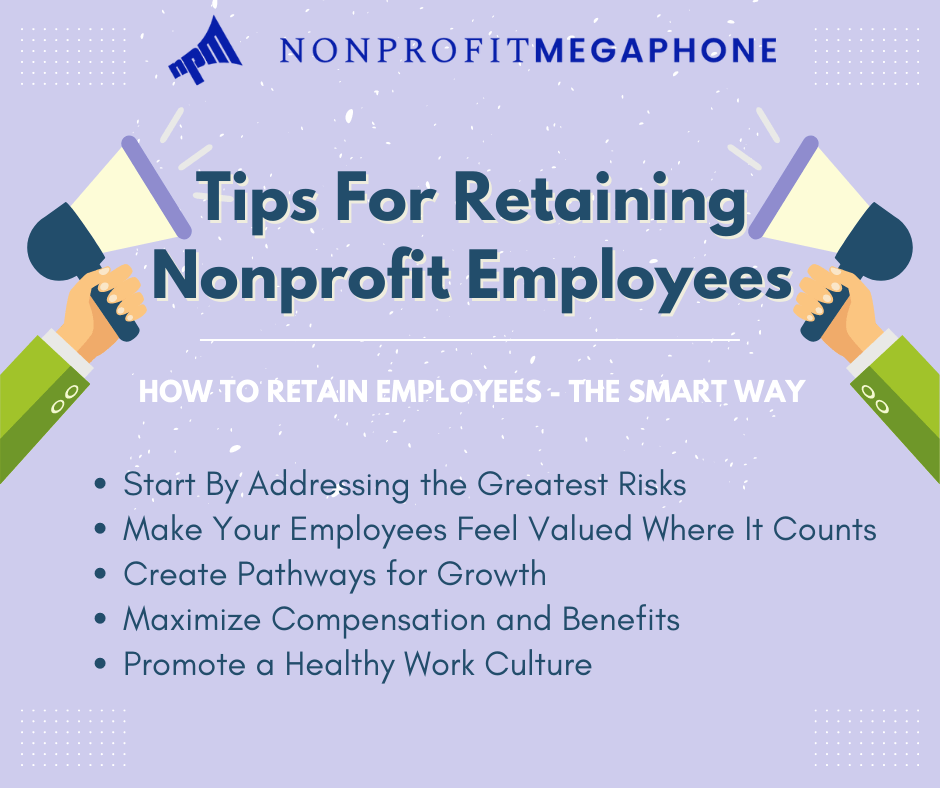
[PODCAST] Myths and Realities of Major Gift Solicitation
February 24, 2023
[PODCAST] How to Assemble and Maintain A Volunteer Fundraising Structure
March 4, 2023Tips For Retaining Nonprofit Employees

Tips for Retaining Nonprofit Employees
Nonprofit executive directors and hiring managers have notoriously over-packed schedules and to-do lists, so if you’re blissfully relieved to cross off your “fill x role” task once a candidate has accepted your job offer, it’s certainly understandable. However, it’s wise to think of that box as being temporarily checked—and to implement strategies to ensure it stays that way for as long as possible. For many reasons, employee retention should be just as integral to pursuing your mission as fundraising and providing core services are.
As of 2022, the average turnover for nonprofit organizations was approximately 19%, whereas the average all-industry turnover rate was 12%. If you’d like to improve your organization’s statistics, but the prospect of designing a comprehensive employee retention plan sounds more overwhelming than organizing your next major fundraiser, don’t worry. Employee retention strategies can be simple, budget-friendly, and fine-tuned over time. In fact, they’re not unlike the practices you already have in place for retaining donors.
If your donors provide the fuel your organization runs on, then your employees are your engine, wheels, and everything in between (your drivetrain, to be exact). We all know that extending the life and quality of your vehicle requires regular tune-ups, repairs, and general TLC. Here’s how to take optimal care of the most valuable (and expensive) parts of your vehicle: your staff.
How To Retain Employees—The Smart Way

Start by Addressing the Greatest Risks
Although you will ultimately want to tailor your retention strategies to your organization’s specific concerns, it can be helpful to start with a high-level view of the factors behind national nonprofit employee retention rate and turnover statistics. The single greatest reason for voluntary turnover is lack of opportunity for growth at 59.7%, inadequate compensation and benefits is second at 47.6%, and discomfort or dissatisfaction with an organization or its culture is third at 26.2%.
Consider prioritizing these areas first as you work through your retention plan, but use your own information-gathering strategies to prevent or address other potential pain points. Exit interviews can certainly be a useful tool in this regard, but in a more preventive sense, it’s a good idea to solicit feedback in the form of anonymous surveys, routine “check-ins,” and other communication tools. But once you’ve determined your areas to address, what are the best ways to, well, address them?
Make Your Employees Feel Valued Where It Counts
In many ways, designing an effective employee retention plan boils down to tried-and-true methods of making your employees feel valued. You already have a system for keeping your donors coming back, and you can deploy a similar one for your workers. Here are some ways to address the biggest risk factors for turnover.
Create Pathways for Growth (Vertical and Lateral)
Given that nonprofits have a reputation for doing more with less, there’s no such thing as a redundant or superfluous employee. But you can’t expect to hold onto people skilled at running in a variety of gears if your workers feel like they’ve hit a career cul-de-sac. Even if you can’t offer them a promotion (vertical growth) in the near future, you can still make sure they’re learning and growing in their existing roles (lateral growth). Here are a few ways you can offer opportunities for career development:
- Promote staff internally where possible
- Provide professional development and training opportunities
- Offer challenges and “stretch” assignments
- Provide mentorship
- Send employees to industry events (like conferences and workshops)
- Pay for field-relevant certifications
Maximize Compensation and Benefits (Get Creative!)
It’s important to offer your employees a competitive salary and benefits package, since this is the second most-cited reason for voluntary turnover. Don’t let a tight budget be a roadblock, however: smaller tangible and significant intangible benefits can go a long way toward making your organization a truly desirable place to work. Here are some ways to show your workers that you’re committed to their welfare:
- Review your budget for ways to increase compensation and traditional benefits; remember to calculate your turnover costs and keep these in mind as you weigh your options
- Consider cost-of-living adjustments in pay
- If your organization can’t afford pay increases right now, offer commissions or bonuses instead
- Increase paid sick, family, or holiday leave allowances
- Ease work/life “pain points” by offering things like on-site childcare, a flexible work schedule (in person or from home), public transit passes, or stipends to help cover other personal or work-related expenses
Promote a Healthy Work Culture
Good company culture doesn’t happen by accident, nor will it thrive with good intentions that are haphazardly applied. Since your workplace culture directly affects how your employees feel about working for your organization, it’s essential to cultivate one in a deliberate and thoughtful way. Think about ways not only to prevent interpersonal conflicts, but to help employees feel comfortable, trusted, valued, and engaged as a team—and in all things, be consistent. Here are a few ways to do this:
- Develop, communicate, and demonstrate your organization’s core values (“walk the walk”)
- Be transparent with employees about organization goals, policies, decisions, and budget
- Solicit feedback often; include workers in major and minor decision-making whenever possible
- Champion equity and inclusiveness
- Have a zero-tolerance policy for bullying, harassment, and other toxic or criminal workplace behavior
Other Ways To Prevent Turnover
If you have open lines of communication in your organization that your employees feel comfortable using, you’ll be alerted to other potential turnover risk factors, and you can get ahead of them before they escalate. Here are some simple, low-cost ideas:
- Provide recognition and let staff know when their hard work has had a concrete positive impact on your organization
- Get to know your employees as individuals
- Make time for fun and feel-good activities (e.g. happy hours, lunches, movie screenings, contests, etc. based on shared team preferences rather than arbitrary top-down ideas)
- Find ways to promote work/life balance in deed, not just in lip service
- Facilitate opportunities for interpersonal and team bonding
You can’t prevent all turnover, of course, voluntary or otherwise, but you can certainly reduce it by implementing thoughtful strategies for employee retention. When you do this, you’ll accomplish much more than simply keeping your best people for longer. You’ll increase loyalty and productivity, reach more goals, enjoy more growth, and create an enjoyable work environment.
As the word gets out that your organization is a great place to work, you can attract (and keep!) more top-notch talent, ensuring the engine of your nonprofit is firing on all cylinders. After all, who doesn’t want an upgraded ride?
Want more tips like these? Get them here.
The post Tips For Retaining Nonprofit Employees appeared first on Nonprofit Hub.
